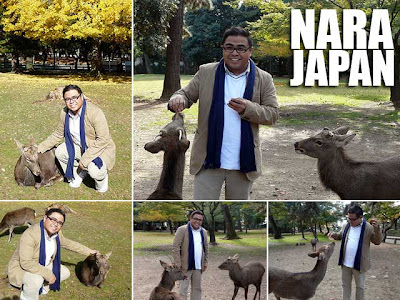 The next day, we headed to Nara, Japan, another UNESCO World Heritage Site (Historic Monuments of Ancient Nara), and another former capital of Japan. Train tickets are free seating so it didn’t matter what time we boarded but we made sure to get a train as early as we could so we could see more attractions. The ride took us a little over 30 minutes.
The next day, we headed to Nara, Japan, another UNESCO World Heritage Site (Historic Monuments of Ancient Nara), and another former capital of Japan. Train tickets are free seating so it didn’t matter what time we boarded but we made sure to get a train as early as we could so we could see more attractions. The ride took us a little over 30 minutes.
 In Nara, we made sure to pass by the tourism desk to ask all the information we needed. We also got a bus day pass at Y500 which was convenient as in the other cities. Our first stop was Kofuku-ji Temple where we saw a very peculiar attraction of the city, wild deer which roam around Nara freely.
In Nara, we made sure to pass by the tourism desk to ask all the information we needed. We also got a bus day pass at Y500 which was convenient as in the other cities. Our first stop was Kofuku-ji Temple where we saw a very peculiar attraction of the city, wild deer which roam around Nara freely.In fact, tourists can feed the deer by purchasing wafers from vendors. It’s fun feeding the deer and they can get aggressive too, nudging you with their head so to grab your attention so that you’d feed them more wafers.

 When in Nara, make sure you visit the Todai-ji Temple. Its Great Buddha Hall or Daibutsuden is the largest wooden structure in the world and houses the largest statue of the Buddha Vairocana in the world. Entrance fee is Y500.
When in Nara, make sure you visit the Todai-ji Temple. Its Great Buddha Hall or Daibutsuden is the largest wooden structure in the world and houses the largest statue of the Buddha Vairocana in the world. Entrance fee is Y500.I was awestruck walking into this massive temple complex. Inside the Daibutsuden are more massive statues. I really took time absorbing the grandeur and size of the building and its contents. And these were all made hundreds of years ago.
 We visited one last attraction in Nara, the Kasuga Taisha Shrine which is known for the many stone lanterns that lead up to the main shrine. My companions had temple and shrine fatigue so we did not enter anymore. So we missed the bronze lanterns inside the main Shinto shrine as well as the Kasugayama Primeval Forest, also part of the UNESCO World Heritage inscription.
We visited one last attraction in Nara, the Kasuga Taisha Shrine which is known for the many stone lanterns that lead up to the main shrine. My companions had temple and shrine fatigue so we did not enter anymore. So we missed the bronze lanterns inside the main Shinto shrine as well as the Kasugayama Primeval Forest, also part of the UNESCO World Heritage inscription.

No comments:
Post a Comment